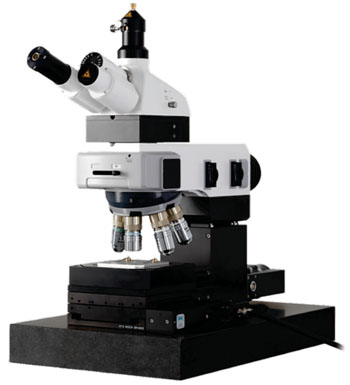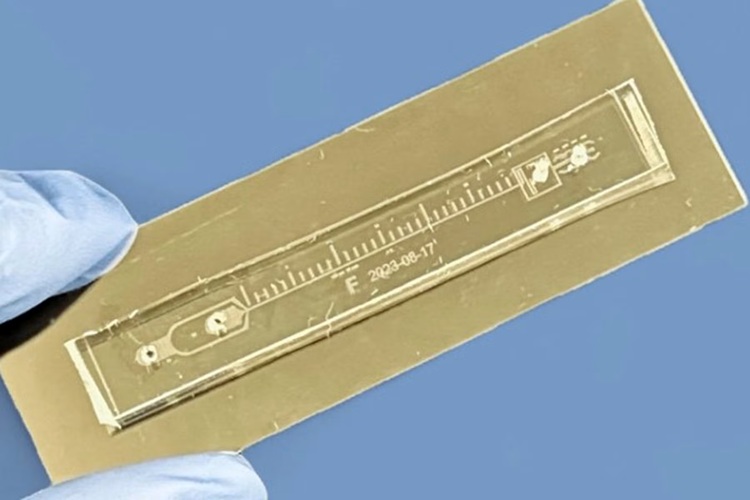Microfluidic Device Rapidly Detects Urinary Tract Infections
|
By LabMedica International staff writers Posted on 23 Aug 2015 |

Image: The workflow of the Lab-on-a-Disc device for identifying bacteria in urine samples. From left to right (i) Urine sample from patient; (ii) Capturing bacteria in V-cup-structures on a Lab-on-a-Disk platform by centrifugation; (iii) Raman spectroscopic analysis of captured bacteria within the V-cups; (iv) Fingerprint-like spectroscopic information on the UTI pathogen (Photo courtesy of Ute Neugebauer).

Image: The alpha300 R Superior Confocal Raman Imaging System (Photo courtesy of WITec).
A polymeric centrifugal microfluidic platform has been developed for the rapid and sensitive identification of bacteria directly from urine, thus eliminating time-consuming cultivation steps.
Untreated urinary tract infections can quickly move to a life-threatening condition and cases may trigger sepsis, which occurs when the immune system, in an attempt to fight off the infection, inadvertently activates body-wide inflammation that can cause blood clots and leaky blood vessels.
Scientists at the Jena University Hospital (Germany) have created a Lab-on-a-Disc platform that combines microfluidics and Raman microscopy, a modern optical detection method. The platform utilizes the rotationally induced centrifugal field to efficiently capture bacteria directly from suspension within a glass-polymer hybrid chip. Once trapped in an array of small V-shaped structures, the bacteria are readily available for spectroscopic characterization, such as Raman spectroscopic fingerprinting, providing valuable information on the characteristics of the captured bacteria.
Anonymized urine samples were provided by the hospital’s Institute of Medical Microbiology. They originated from different patients with single pathogen urinary tract infections (UTIs) of Enterococcus faecalis and Escherichia coli. To remove bigger particles such as leukocytes or epithelial cells, the urine samples were run through membrane filters, centrifuged, the pellet washed twice with phosphate buffered saline (PBS), and is finally re-suspended in PBS before being loaded into the device. A CRM 300 micro-Raman setup (WITec, Ulm, Germany), equipped with a 600 lines/mm grating was used for micro-Raman measurements.
The whole procedure, including sample preparation, requires about one hour to obtain a valuable result, marking a significant reduction in diagnosis time when compared to the 24 hours and more, typically required for standard microbiological methods. Characterization of the captured bacteria by label-free conventional micro-Raman spectroscopy allows rapid identification of the pathogens with their characteristic features, which is valuable for first screening analysis. The device has been easily adapted for fluorescence measurements, paving the way for the development of microfluidics-based immunochemical assays, illustrating a high potential of the device for numerous applications in spectroscopy-based point-of-care diagnostics.
Ulrich-Christian Schröder, a doctoral student and lead author of the study said, “Our device works by loading a few microliters of a patient's urine sample into a tiny chip, which is then rotated with a high angular velocity so that any bacteria is guided by centrifugal force through microfluidic channels to a small chamber where 'V-cup capture units' collect it for optical investigation. We were able to identify Escherichia coli and Enterococcus faecalis within 70 minutes, directly from patients' urine samples.” The study was published on August 11, 2015, in the journal Biomicrofluidics.
Related Links:
Jena University Hospital
WITec
Untreated urinary tract infections can quickly move to a life-threatening condition and cases may trigger sepsis, which occurs when the immune system, in an attempt to fight off the infection, inadvertently activates body-wide inflammation that can cause blood clots and leaky blood vessels.
Scientists at the Jena University Hospital (Germany) have created a Lab-on-a-Disc platform that combines microfluidics and Raman microscopy, a modern optical detection method. The platform utilizes the rotationally induced centrifugal field to efficiently capture bacteria directly from suspension within a glass-polymer hybrid chip. Once trapped in an array of small V-shaped structures, the bacteria are readily available for spectroscopic characterization, such as Raman spectroscopic fingerprinting, providing valuable information on the characteristics of the captured bacteria.
Anonymized urine samples were provided by the hospital’s Institute of Medical Microbiology. They originated from different patients with single pathogen urinary tract infections (UTIs) of Enterococcus faecalis and Escherichia coli. To remove bigger particles such as leukocytes or epithelial cells, the urine samples were run through membrane filters, centrifuged, the pellet washed twice with phosphate buffered saline (PBS), and is finally re-suspended in PBS before being loaded into the device. A CRM 300 micro-Raman setup (WITec, Ulm, Germany), equipped with a 600 lines/mm grating was used for micro-Raman measurements.
The whole procedure, including sample preparation, requires about one hour to obtain a valuable result, marking a significant reduction in diagnosis time when compared to the 24 hours and more, typically required for standard microbiological methods. Characterization of the captured bacteria by label-free conventional micro-Raman spectroscopy allows rapid identification of the pathogens with their characteristic features, which is valuable for first screening analysis. The device has been easily adapted for fluorescence measurements, paving the way for the development of microfluidics-based immunochemical assays, illustrating a high potential of the device for numerous applications in spectroscopy-based point-of-care diagnostics.
Ulrich-Christian Schröder, a doctoral student and lead author of the study said, “Our device works by loading a few microliters of a patient's urine sample into a tiny chip, which is then rotated with a high angular velocity so that any bacteria is guided by centrifugal force through microfluidic channels to a small chamber where 'V-cup capture units' collect it for optical investigation. We were able to identify Escherichia coli and Enterococcus faecalis within 70 minutes, directly from patients' urine samples.” The study was published on August 11, 2015, in the journal Biomicrofluidics.
Related Links:
Jena University Hospital
WITec
Latest Microbiology News
- Rapid Assay Identifies Bloodstream Infection Pathogens Directly from Patient Samples
- Blood-Based Molecular Signatures to Enable Rapid EPTB Diagnosis
- 15-Minute Blood Test Diagnoses Life-Threatening Infections in Children
- High-Throughput Enteric Panels Detect Multiple GI Bacterial Infections from Single Stool Swab Sample
- Fast Noninvasive Bedside Test Uses Sugar Fingerprint to Detect Fungal Infections
- Rapid Sepsis Diagnostic Device to Enable Personalized Critical Care for ICU Patients
- Microfluidic Platform Assesses Neutrophil Function in Sepsis Patients
- New Diagnostic Method Confirms Sepsis Infections Earlier
- New Markers Could Predict Risk of Severe Chlamydia Infection
- Portable Spectroscopy Rapidly and Noninvasively Detects Bacterial Species in Vaginal Fluid
- CRISPR-Based Saliva Test Detects Tuberculosis Directly from Sputum
- Urine-Based Assay Diagnoses Common Lung Infection in Immunocompromised People
- Saliva Test Detects Implant-Related Microbial Risks
- New Platform Leverages AI and Quantum Computing to Predict Salmonella Antimicrobial Resistance
- Early Detection of Gut Microbiota Metabolite Linked to Atherosclerosis Could Revolutionize Diagnosis
- Viral Load Tests Can Help Predict Mpox Severity
Channels
Clinical Chemistry
view channel
Chemical Imaging Probe Could Track and Treat Prostate Cancer
Prostate cancer remains a leading cause of illness and death among men, with many patients eventually developing resistance to standard hormone-blocking therapies. These drugs often lose effectiveness... Read more
Mismatch Between Two Common Kidney Function Tests Indicates Serious Health Problems
Creatinine has long been the standard for measuring kidney filtration, while cystatin C — a protein produced by all human cells — has been recommended as a complementary marker because it is influenced... Read moreMolecular Diagnostics
view channel
New Genetic Test Enables Faster Diagnosis of Rare Diseases
Rare disease diagnosis often involves a long and uncertain search for the underlying genetic cause. Traditional testing requires multiple separate analyses, although many patients remain without answers.... Read more
Urine Test Detects Inherited Neuropathy Missed by Genetic Screening
Sorbitol dehydrogenase (SORD)-related neuropathy is one of the most common inherited nerve disorders, yet diagnosis often lags because current genetic screens frequently miss the causal gene.... Read moreHematology
view channel
Platelet Activity Blood Test in Middle Age Could Identify Early Alzheimer’s Risk
Early detection of Alzheimer’s disease remains one of the biggest unmet needs in neurology, particularly because the biological changes underlying the disorder begin decades before memory symptoms appear.... Read more
Microvesicles Measurement Could Detect Vascular Injury in Sickle Cell Disease Patients
Assessing disease severity in sickle cell disease (SCD) remains challenging, especially when trying to predict hemolysis, vascular injury, and risk of complications such as vaso-occlusive crises.... Read more
ADLM’s New Coagulation Testing Guidance to Improve Care for Patients on Blood Thinners
Direct oral anticoagulants (DOACs) are one of the most common types of blood thinners. Patients take them to prevent a host of complications that could arise from blood clotting, including stroke, deep... Read moreImmunology
view channel
Chip Captures Cancer Cells from Blood to Help Select Right Breast Cancer Treatment
Ductal carcinoma in situ (DCIS) accounts for about a quarter of all breast cancer cases and generally carries a good prognosis. This non-invasive form of the disease may or may not become life-threatening.... Read more
Blood-Based Liquid Biopsy Model Analyzes Immunotherapy Effectiveness
Immunotherapy has revolutionized cancer care by harnessing the immune system to fight tumors, yet predicting who will benefit remains a major challenge. Many patients undergo costly and taxing treatment... Read moreMicrobiology
view channel
Rapid Assay Identifies Bloodstream Infection Pathogens Directly from Patient Samples
Bloodstream infections in sepsis progress quickly and demand rapid, precise diagnosis. Current blood-culture methods often take one to five days to identify the pathogen, leaving clinicians to treat blindly... Read more
Blood-Based Molecular Signatures to Enable Rapid EPTB Diagnosis
Extrapulmonary tuberculosis (EPTB) remains difficult to diagnose and treat because it spreads beyond the lungs and lacks easily accessible biomarkers. Despite TB infecting 10 million people yearly, the... Read more
15-Minute Blood Test Diagnoses Life-Threatening Infections in Children
Distinguishing minor childhood illnesses from potentially life-threatening infections such as sepsis or meningitis remains a major challenge in emergency care. Traditional tests can take hours, leaving... Read more
High-Throughput Enteric Panels Detect Multiple GI Bacterial Infections from Single Stool Swab Sample
Gastrointestinal (GI) infections are among the most common causes of illness worldwide, leading to over 1.7 million deaths annually and placing a heavy burden on healthcare systems. Conventional diagnostic... Read morePathology
view channel
Blood Test and Sputum Analysis Predict Acute COPD Exacerbation
Chronic obstructive pulmonary disease (COPD) remains a major contributor to global illness, largely driven by cigarette smoking and marked by irreversible lung damage. Acute exacerbations can accelerate... Read more
AI Tool to Transform Skin Cancer Detection with Near-Perfect Accuracy
Melanoma continues to be one of the most difficult skin cancers to diagnose because it often resembles harmless moles or benign lesions. Traditional AI tools depend heavily on dermoscopic images alone,... Read more
Unique Immune Signatures Distinguish Rare Autoimmune Condition from Multiple Sclerosis
Myelin oligodendrocyte glycoprotein antibody–associated disease (MOGAD) is a rare autoimmune disorder in which the immune system attacks the myelin sheath in the central nervous system. Although symptoms... Read moreIndustry
view channel
Abbott Acquires Cancer-Screening Company Exact Sciences
Abbott (Abbott Park, IL, USA) has entered into a definitive agreement to acquire Exact Sciences (Madison, WI, USA), enabling it to enter and lead in fast-growing cancer diagnostics segments.... Read more




 assay.jpg)

















